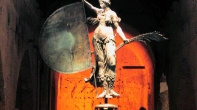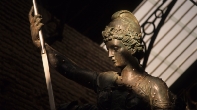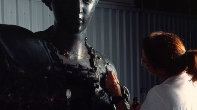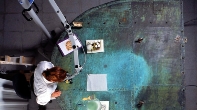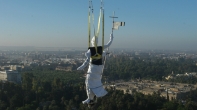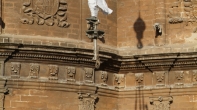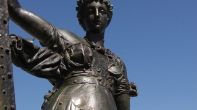Galería
Between 1999 and 2005, the Andalusian Historical Heritage Institute carried out the project of research and restoration of the bronze statue called the Colossus of the Victorious Faith, popularly known as Giraldillo, which ended with its placing on the Giralda tower in July 2005.
The research work carried out has allowed understanding the Giraldillo: the Colossus is a magnificent mechanical device designed to move, and not just a mere bronze statute. Starting from the ideographic historical nature of the Giraldillo as a weather vane, the project aims at protecting the functionality of the mechanical device, as it is historically and culturally a defining element of the Colossus. All this without neglecting the preservation of the remaining formal, material and symbolic values of the piece
The research and restoration work made by the IAPH team of experts has required implementing mixed criteria: for sculpture (minimum restoration and compatible materials), and for the mechanical system, making a structure that allowed the maintenance of its function, that is, the movement of the weather vane, hold it and keep it right next to the tower.
In order to do so, the most advanced technology, the most resistant materials, and the best services have been used. This way the historical conceptual meaning of the work has been recovered.
The works have been made both in the historic and scientific-technical fields. The history of the piece has provided the keys for its symbolic, iconographic and iconological interpreting, with regard to the tower and the city of at the time when it was restored. This has allowed establishing the making technique, the alterations and restoration it has undergone, and a hypothesis about the origin of the copper used to make the sculpture.
The research about the device preservation state ahs been carried out combining an exhaustive visual inspection with the details provided after different using experimental techniques: gammagraphy, chemical analysis, metallographic analysis, etc. The treatment of the bronze has consisted of cleaning, crack and other fissure sealing, and applying a final patina layer and superficial protection treatment. In order to select the most appropriate products and methods, different trials and proofs have been carried out.
The study of the mechanical behaviour ahs been mainly due to learn about the past damage causes and suggest and implement the necessary correcting measures. It was done making a mathematical model of the sculpture (finite element model) in which all the variables that can affect it were simulated, thus obtaining the strains appearing in each area. On this model, the different forces acting on the piece have been superimposed: the load due to its actual weight, the effort caused by the temperature differences and the force made by the wind at different speed and from different directions. In order to know the mechanics of the work and the resistance of the material it was essential to learn about the design of the historical structures, particularly that of 1770.
This structure, that has traditionally had a good behaviour, was the cause of a large part of the Giraldillo problems. That’s why the aim of the technical work was to keep the historic structure values but providing solutions to the specific problems it had.
The new structure shares certain principles with the pre-existing one. You could say that it has been carried out following the instructions of the person who led the repair work back in 1770, where a similar work with the same aim was made. The geometry of the structure is very similar to the old one, but those aspects that caused problems have been improved thus being now in a reliable safe situation. The new structure implies an important innovation work in several aspects. It has been made of stainless steel -316, which is also much more resistant mechanically and its features make it compatible with the sculpture bronze. Another important change is in the structure’s central part. The previous one behaved like a plain structure, supported on the Colossus shoulders, back and chest. This new piece makes the new structure a three-dimensional one and the centre of gravity centre is now inside it, thus eliminating its original swaying, which caused a large part of the damage the Giraldillo had. Finally, the palm and the banner, which originally loaded their weight on the sculpture and caused the cracks and fractures on both arms, but now are linked to the internal structure which resists the load of these two elements.
Finally, the possibility of a maintenance program including periodical revisions was also considered.
This Project implied the recovery of one of the great bronze sculpture of Europe.
Works of the catalogue id restored works related to the Giraldillo project
- Concert by Bartolomé Morel to make a bronze sculpture and finish off the Cathedral tower. (Giraldillo). Historical Provincial Archive of Seville.
- The Colossus of the Victorious Faith: the Giraldillo
Share this
